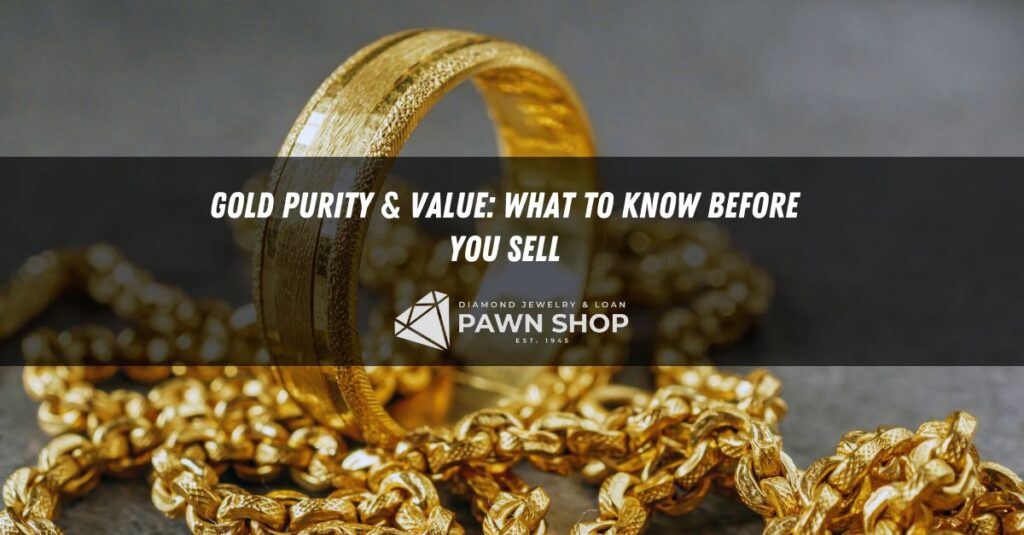Your jewelry box could be holding more than just sentimental value. That gold necklace or old ring might be a source of quick cash when you need it most. But before you decide to sell or get a loan, it’s crucial to understand what makes your gold valuable. One of the most significant factors is its purity, measured in gold karats.
Understanding the karat system is the key to unlocking the true worth of your gold items. This guide will walk you through what different karat ratings mean, how purity directly impacts price, and what you can expect when you bring your gold to a reputable buyer. With this knowledge, you can confidently navigate the selling process and ensure you receive a fair price for your valuables.

What Are Gold Karats?
When we talk about gold karats (K), we’re referring to the purity of the gold. Since pure gold is very soft, it’s often mixed with other metals, called alloys, to increase its durability for use in jewelry. These alloys can include copper, silver, nickel, and zinc. The karat number tells you the ratio of pure gold to other metals in your item.
The system is based on a scale of 24 parts. Therefore, 24-karat gold is the purest form you can get, consisting of 24 out of 24 parts gold.
Understanding the Gold Karat System
Here’s a simple breakdown of the most common karat ratings you’ll encounter and what they mean:
- 24K Gold (99.9% Pure Gold): This is gold in its purest form. Because it’s so soft and malleable, it’s rarely used for everyday jewelry. Instead, you’ll typically find it in the form of gold bars, coins, or certain types of fine jewelry from specific regions.
- 22K Gold (91.7% Pure Gold): Containing 22 parts gold and 2 parts other metals, 22K gold is still quite soft but durable enough for intricate jewelry. It has a rich, deep yellow hue that is highly desirable.
- 18K Gold (75% Pure Gold): A popular choice for fine jewelry, 18K gold offers a great balance between purity and strength. It’s composed of 18 parts gold and 6 parts alloy, giving it a beautiful golden color while being sturdy enough for regular wear.
- 14K Gold (58.3% Pure Gold): This is one of the most common types of gold for jewelry in the United States. With 14 parts gold and 10 parts alloy, it’s significantly more durable and resistant to scratches, making it perfect for items like engagement rings and everyday necklaces.
- 10K Gold (41.7% Pure Gold): As the most durable option, 10K gold contains 10 parts gold and 14 parts alloy. While it has the lowest gold content considered to be real gold in the U.S., it’s a very affordable and resilient choice for jewelry.
How Purity Affects Your Gold’s Value
The relationship between Gold Karats and value is straightforward: the higher the karat, the higher the gold content, and therefore, the more valuable it is.
When you bring a gold item to a pawn shop or gold buyer, the first step in the appraisal process is to determine its karat. This is because the price you are offered will be based on the actual amount of pure gold in your item, not its total weight.
For example, let’s say you have a 10-gram necklace made of 14K gold and another 10-gram necklace made of 24K gold.
- The 14K necklace contains 5.83 grams of pure gold (10g x 58.3%).
- The 24K necklace contains 9.99 grams of pure gold (10g x 99.9%).
Even though both necklaces weigh the same, the 24K piece has significantly more pure gold, making it almost twice as valuable. The final offer will be calculated based on this “melt value” of the pure gold content, tied to the current market price of gold.

Professional Assessment of Gold Karats and Purity
At Diamond Jewelry & Loan, we use precise, industry-standard methods to ensure you get an accurate and fair assessment of your gold’s value. When you bring your items to our Los Angeles shop, our expert appraisers follow a transparent process.
- Visual Inspection: Most jewelry makers stamp each piece with its karat mark, such as “14K,” “18K,” or numbers like “585” and “750.”
- Magnet Test: Gold is not magnetic. We’ll use a strong magnet to check whether your item attracts it. If it is, it’s likely not real gold or has a very low purity.
- Acid Scratch Test: This is a definitive way to verify purity. We’ll make a tiny, unnoticeable scratch on a testing stone and apply a specific acid solution to the gold marking. The way the gold reacts (or doesn’t react) to the acid confirms its karat. We have different acids for each karat level, allowing for a highly accurate test.
This careful evaluation guarantees that we can offer you top dollar, whether you’re looking to sell your gold or use it for a collateral loan.
Maximize Your Return at a Trusted Pawn Shop
When you’re ready to sell your gold or secure a loan, choosing the right partner is just as important as understanding your item’s purity. You need a buyer who is trustworthy, experienced, and transparent.
For over 75 years, Diamond Jewelry & Loan has been serving the Los Angeles community. As one of the oldest and most respected pawn shops in the area, we’ve built our reputation on honesty and fair dealing. We are a BBB-accredited business and are fully licensed, bonded, and insured, giving you peace of mind throughout the transaction. Our expertise makes us one of the biggest gold buying businesses in the region, which allows us to offer you the best possible price for your valuables.
Don’t let that unused jewelry sit idle. Bring it to our team for a free, no-obligation appraisal and discover its true worth.


